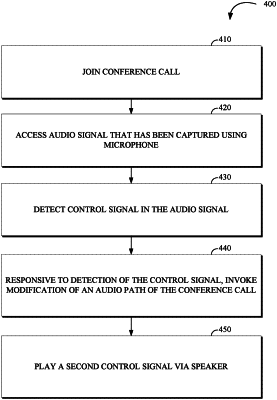| CPC H04L 12/1813 (2013.01) [G06F 3/165 (2013.01); G10L 25/78 (2013.01); H04M 3/568 (2013.01); H04M 9/02 (2013.01)] | 20 Claims |

|
1. A method comprising:
joining, by a first computing device, a conference call;
detecting, by a microphone of the first computing device, an absence of an audio signal that includes a control signal;
emitting, by a speaker of the first computing device, an audio signal that includes a control signal associated with the first computing device and indicating that the first computing device is a primary device of an audio environment associated with the conference call;
joining, by a second computing device, the conference call;
detecting, by a microphone of the second computing device, the audio signal that includes the control signal associated with the first computing device;
determining, based at least in part on the control signal associated with the first computing device, that the second computing device shares the audio environment with the primary device; and
based at least in part on determining that the second computing device shares the audio environment with the primary device, modifying an audio path of the conference call.
|
|
8. A system comprising:
one or more processors; and
one or more non-transitory computer-readable media storing computer-executable instructions that, when executed by the one or more processors, cause the one or more processors to perform operations comprising:
joining, by a first computing device, a conference call;
detecting, by a microphone of the first computing device, an absence of an audio signal that includes a control signal;
emitting, by a speaker of the first computing device, an audio signal that includes a control signal associated with the first computing device and indicating that the first computing device is a primary device of an audio environment associated with the conference call;
joining, by a second computing device, the conference call;
detecting, by a microphone of the second computing device, the audio signal that includes the control signal associated with the first computing device;
determining, based at least in part on the control signal associated with the first computing device, that the second computing device shares the audio environment with the primary device; and
based at least in part on determining that the second computing device shares the audio environment with the primary device, modifying an audio path of the conference call.
|
|
15. One or more non-transitory computer-readable media storing instructions that, when executed, cause one or more processors to perform operations comprising:
joining, by a first computing device, a conference call;
detecting, by a microphone of the first computing device, an absence of an audio signal that includes a control signal;
emitting, by a speaker of the first computing device, an audio signal that includes a control signal associated with the first computing device and indicating that the first computing device is a primary device of an audio environment associated with the conference call;
joining, by a second computing device, the conference call;
detecting, by a microphone of the second computing device, the audio signal that includes the control signal associated with the first computing device;
determining, based at least in part on the control signal associated with the first computing device, that the second computing device shares the audio environment with the primary device; and
based at least in part on determining that the second computing device shares the audio environment with the primary device, modifying an audio path of the conference call.
|